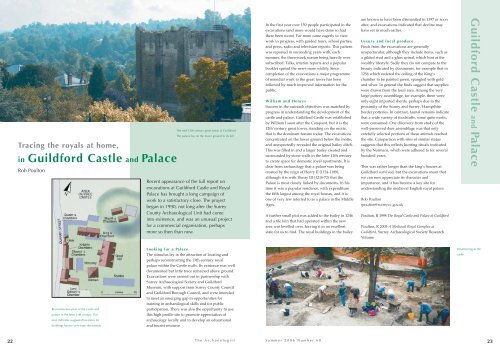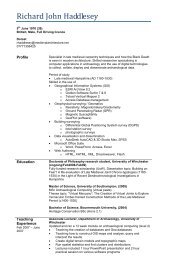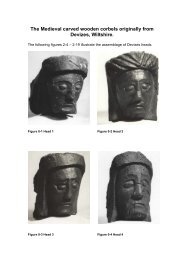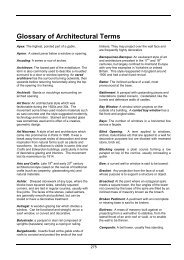The ARCHAEOLOGIST - English Late-Medieval timber-framed ...
The ARCHAEOLOGIST - English Late-Medieval timber-framed ...
The ARCHAEOLOGIST - English Late-Medieval timber-framed ...
You also want an ePaper? Increase the reach of your titles
YUMPU automatically turns print PDFs into web optimized ePapers that Google loves.
Tracing the royals at home,<br />
in Guildford Castle and Palace<br />
Rob Poulton<br />
<strong>The</strong> mid-12th century great tower at Guildford.<br />
<strong>The</strong> palace lay on the lower ground to its left<br />
Recent appearance of the full report on<br />
excavations at Guildford Castle and Royal<br />
Palace has brought a long campaign of<br />
work to a satisfactory close. <strong>The</strong> project<br />
began in 1990, not long after the Surrey<br />
County Archaeological Unit had come<br />
into existence, and was an unusual project<br />
for a commercial organisation, perhaps<br />
more so then than now.<br />
In the first year over 150 people participated in the<br />
excavations (and more would have done so had<br />
there been room). Far more came eagerly to view<br />
work in progress, with guided tours, school parties,<br />
and press, radio and television reports. This pattern<br />
was repeated in succeeding years with, each<br />
summer, the three-week season being heavily over<br />
subscribed. Talks, interim reports and a popular<br />
booklet spread the news more widely. Since<br />
completion of the excavations a major programme<br />
of remedial work to the great tower has been<br />
followed by much improved information for the<br />
public.<br />
William and Henrys<br />
Success in the outreach objectives was matched by<br />
progress in understanding the development of the<br />
castle and palace. Guildford Castle was established<br />
by William I soon after the Conquest, but it is the<br />
12th - century great tower, standing on the motte,<br />
that is the dominant feature today. <strong>The</strong> excavations<br />
concentrated on the lower ground below the motte,<br />
and unexpectedly revealed the original bailey ditch.<br />
This was filled in and a larger bailey created and<br />
surrounded by stone walls in the later 12th century<br />
to create space for domestic royal apartments. It is<br />
clear from archaeology that a palace was being<br />
created by the reign of Henry II (1154-1189),<br />
although it is with Henry III (1216-72) that the<br />
Palace is most closely linked by documents. In his<br />
time it was a popular residence, with expenditure<br />
the fifth largest among the royal houses, and it is<br />
one of very few referred to as a palace in the Middle<br />
Ages.<br />
A further small plot was added to the bailey in 1246<br />
and a tile kiln that had operated within the new<br />
area was levelled over, leaving it in an excellent<br />
state for us to find. <strong>The</strong> royal buildings in the bailey<br />
are known to have been dismantled in 1397 or soon<br />
after, and excavations indicated that decline may<br />
have set in much earlier.<br />
Luxury and local produce<br />
Finds from the excavations are generally<br />
unspectacular, although they include items, such as<br />
a gilded stud and a glass urinal, which hint at the<br />
wealthy lifestyle. Sadly they do not compare to the<br />
beauty indicated by documents, for example that in<br />
1256 which ordered the ceiling of the King’s<br />
chamber to be painted green, spangled with gold<br />
and silver. In general the finds suggest that supplies<br />
were drawn from the local area. Among the very<br />
large pottery assemblage, for example, there were<br />
only eight imported sherds, perhaps due to the<br />
proximity of the Surrey and Surrey/Hampshire<br />
border potteries. In contrast, faunal remains indicate<br />
that a wide variety of foodstuffs, some quite exotic,<br />
were consumed. One discovery from study of the<br />
well-preserved deer assemblage was that only<br />
carefully selected portions of these animals reached<br />
the site. Comparison with sites of similar status<br />
suggests that this reflects hunting rituals instituted<br />
by the Normans, which were adhered to for several<br />
hundred years.<br />
This was rather longer than the king’s houses at<br />
Guildford survived, but the excavations mean that<br />
we can now appreciate its character and<br />
importance, and it has become a key site for<br />
understanding the medieval <strong>English</strong> royal palace.<br />
Rob Poulton<br />
rpoulton@surreycc.gov.uk<br />
Poulton, R 1998 <strong>The</strong> Royal Castle and Palace at Guildford<br />
Poulton, R 2005 A <strong>Medieval</strong> Royal Complex at<br />
Guildford, Surrey Archaeological Society Research<br />
Volume<br />
Guildford Castle and Palace<br />
Reconstruction plan of the castle and<br />
palace in the later 13th century. Flat<br />
tone indicates suggested locations for<br />
buildings known only from documents<br />
Looking for a Palace<br />
<strong>The</strong> stimulus lay in the attraction of locating and<br />
perhaps reconstructing the 13th-century royal<br />
palace within the Castle walls. Its existence was well<br />
documented but little trace remained above ground.<br />
Excavations were carried out in partnership with<br />
Surrey Archaeological Society and Guildford<br />
Museum, with support from Surrey County Council<br />
and Guildford Borough Council, and were intended<br />
to meet an emerging gap in opportunities for<br />
training in archaeological skills and for public<br />
participation. <strong>The</strong>re was also the opportunity to use<br />
this high profile site to promote appreciation of<br />
archaeology locally and to develop an educational<br />
and tourist resource.<br />
Volunteering at the<br />
castle<br />
22<br />
<strong>The</strong> Archaeologist<br />
Summer 2006 Number 60<br />
23





